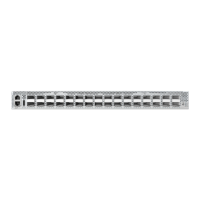C
HAPTER
45
| IP Routing Commands
Open Shortest Path First (OSPFv2)
– 1060 –
COMMAND MODE
Router Configuration
DEFAULT SETTING
Disabled
COMMAND USAGE
◆ An area ID uniquely defines an OSPF broadcast area. The area ID
0.0.0.0 indicates the OSPF backbone for an autonomous system. Each
router must be connected to the backbone via a direct connection or a
virtual link.
◆ Set the area ID to the same value for all routers on a network segment
using the network mask to add one or more interfaces to an area.
◆ If an address range is overlapped in subsequent network area
commands, the router will use the network area with the address range
that most closely matches the interface address. Also, note that if a
more specific address range is removed from an area, the interface
belonging to that range may still remain active if a less specific address
range covering that area has been specified.
EXAMPLE
This example creates the backbone 0.0.0.0 covering class B addresses
10.1.x.x, and a normal transit area 10.2.9.0 covering the class C addresses
10.2.9.x.
Console(config-router)#network 10.1.0.0 255.255.0.0 area 0.0.0.0
Console(config-router)#network 10.2.9.0 255.255.255.0 area 10.1.0.0
Console(config-router)#
ip ospf
authentication
This command specifies the authentication type used for an interface.
Enter this command without any optional parameters to specify plain text
(or simple password) authentication. Use the no form to restore the
default of no authentication.
SYNTAX
ip ospf [ip-address] authentication [message-digest | null]
no ip ospf [ip-address] authentication
ip-address - IP address of the interface. Enter this parameter to
specify a unique authentication type for a primary or secondary IP
address associated with the current VLAN. If not specified, the
command applies to all networks connected to the current interface.
message-digest - Specifies message-digest (MD5) authentication.
null - Indicates that no authentication is used.

